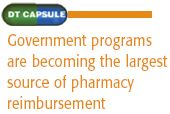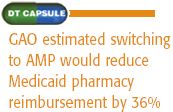BRACING FOR A SHOWDOWN
Pharmacists have temporarily blocked the Medicaid AMP formula, but a bruising battle still awaits.
Average manufacturer price is dead, or is it? Two months after a Federal District Court Judge granted a temporary restraining order, preventing the Centers for Medicare and Medicaid Services from implementing the new generic drug reimbursement model for Medicaid, the future of the reimbursement plan remains up in the air. Still, while it is unclear how or when the case will be resolved, most pharmacy experts agree that pharmacists will continue to see tightening in prescription drug reimbursement.

Unfortunately for many pharmacists, while drug reimbursement formulas are becoming more accurate, dispensing fees are not. Even as payors push for greater accuracy in drug cost models, there has been no comparable change in drug dispensing. According to The Cost of Dispensing, a national study conducted by accounting firm Grant Thornton that was commissioned by the Coalition for Community Pharmacy Action, the national average cost of dispensing medications is $10.50 per prescription, even though the average dispensing fee paid by government programs such as Medicaid is closer to $4.50. (See sidebar).

In 2005, Congress mandated Medicaid change from AWP to AMP in an effort to reduce the budget deficit and rein in spending in the healthcare program. In addition, a group representing unions sued First DataBank, one of the primary publishers of AWP, and the wholesaler McKesson, claiming they willfully manipulated AWP to inflate pharmacy reimbursement. First DataBank had agreed to settle the case and stop publishing AWP data, but in a surprise move Judge Patti Saris has invalidated the settlement. According to sources who attended the hearing, the judge indicated that she was unwilling to allow the elimination of AWP through the settlement. (See "AMP is back from the dead,").
Opponents remain undeterred. "The marketplace is waking up to how rotten AWP is," argued Alex Sugarman-Brozan, director of the Prescription Access Litigation (PAL) Project, which brought the suit.

In taking on AMP, pharmacy organizations have been pulling out all the stops: employing public relations, lobbying, and filing a legal suit to ensure they have a place at the table. "Historically pharmacists have gone after Medicaid because they have more influence in politics," argued Kreling. The only question is whether that will be enough.